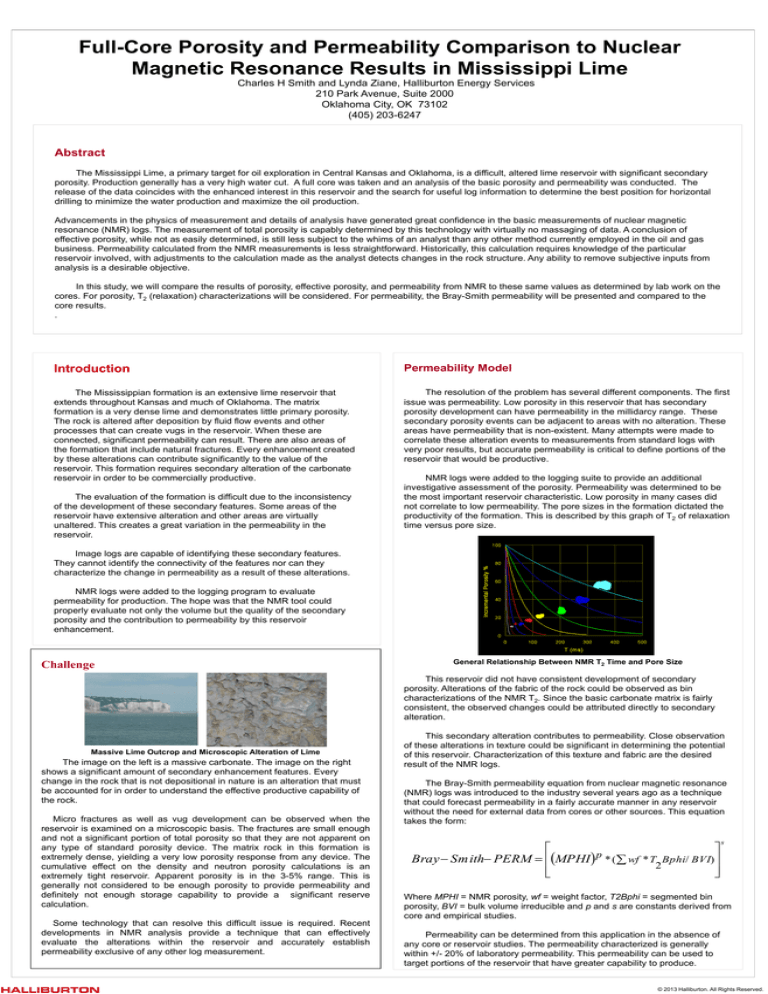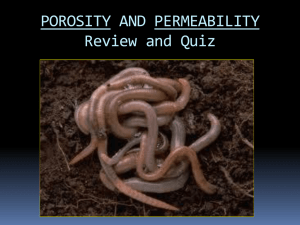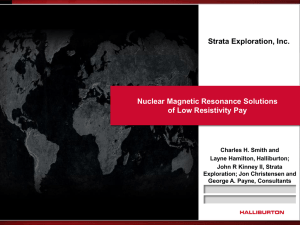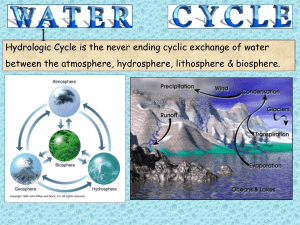
Full-Core Porosity and Permeability Comparison to Nuclear
Magnetic Resonance Results in Mississippi Lime
Charles H Smith and Lynda Ziane, Halliburton Energy Services
210 Park Avenue, Suite 2000
Oklahoma City, OK 73102
(405) 203-6247
Abstract
The Mississippi Lime, a primary target for oil exploration in Central Kansas and Oklahoma, is a difficult, altered lime reservoir with significant secondary
porosity. Production generally has a very high water cut. A full core was taken and an analysis of the basic porosity and permeability was conducted. The
release of the data coincides with the enhanced interest in this reservoir and the search for useful log information to determine the best position for horizontal
drilling to minimize the water production and maximize the oil production.
Advancements in the physics of measurement and details of analysis have generated great confidence in the basic measurements of nuclear magnetic
resonance (NMR) logs. The measurement of total porosity is capably determined by this technology with virtually no massaging of data. A conclusion of
effective porosity, while not as easily determined, is still less subject to the whims of an analyst than any other method currently employed in the oil and gas
business. Permeability calculated from the NMR measurements is less straightforward. Historically, this calculation requires knowledge of the particular
reservoir involved, with adjustments to the calculation made as the analyst detects changes in the rock structure. Any ability to remove subjective inputs from
analysis is a desirable objective.
In this study, we will compare the results of porosity, effective porosity, and permeability from NMR to these same values as determined by lab work on the
cores. For porosity, T2 (relaxation) characterizations will be considered. For permeability, the Bray-Smith permeability will be presented and compared to the
core results.
.
Introduction
Permeability Model
The Mississippian formation is an extensive lime reservoir that
extends throughout Kansas and much of Oklahoma. The matrix
formation is a very dense lime and demonstrates little primary porosity.
The rock is altered after deposition by fluid flow events and other
processes that can create vugs in the reservoir. When these are
connected, significant permeability can result. There are also areas of
the formation that include natural fractures. Every enhancement created
by these alterations can contribute significantly to the value of the
reservoir. This formation requires secondary alteration of the carbonate
reservoir in order to be commercially productive.
The resolution of the problem has several different components. The first
issue was permeability. Low porosity in this reservoir that has secondary
porosity development can have permeability in the millidarcy range. These
secondary porosity events can be adjacent to areas with no alteration. These
areas have permeability that is non-existent. Many attempts were made to
correlate these alteration events to measurements from standard logs with
very poor results, but accurate permeability is critical to define portions of the
reservoir that would be productive.
The evaluation of the formation is difficult due to the inconsistency
of the development of these secondary features. Some areas of the
reservoir have extensive alteration and other areas are virtually
unaltered. This creates a great variation in the permeability in the
reservoir.
NMR logs were added to the logging suite to provide an additional
investigative assessment of the porosity. Permeability was determined to be
the most important reservoir characteristic. Low porosity in many cases did
not correlate to low permeability. The pore sizes in the formation dictated the
productivity of the formation. This is described by this graph of T2 of relaxation
time versus pore size.
Image logs are capable of identifying these secondary features.
They cannot identify the connectivity of the features nor can they
characterize the change in permeability as a result of these alterations.
NMR logs were added to the logging program to evaluate
permeability for production. The hope was that the NMR tool could
properly evaluate not only the volume but the quality of the secondary
porosity and the contribution to permeability by this reservoir
enhancement.
Challenge
General Relationship Between NMR T2 Time and Pore Size
This reservoir did not have consistent development of secondary
porosity. Alterations of the fabric of the rock could be observed as bin
characterizations of the NMR T2. Since the basic carbonate matrix is fairly
consistent, the observed changes could be attributed directly to secondary
alteration.
Massive Lime Outcrop and Microscopic Alteration of Lime
The image on the left is a massive carbonate. The image on the right
shows a significant amount of secondary enhancement features. Every
change in the rock that is not depositional in nature is an alteration that must
be accounted for in order to understand the effective productive capability of
the rock.
Micro fractures as well as vug development can be observed when the
reservoir is examined on a microscopic basis. The fractures are small enough
and not a significant portion of total porosity so that they are not apparent on
any type of standard porosity device. The matrix rock in this formation is
extremely dense, yielding a very low porosity response from any device. The
cumulative effect on the density and neutron porosity calculations is an
extremely tight reservoir. Apparent porosity is in the 3-5% range. This is
generally not considered to be enough porosity to provide permeability and
definitely not enough storage capability to provide a significant reserve
calculation.
Some technology that can resolve this difficult issue is required. Recent
developments in NMR analysis provide a technique that can effectively
evaluate the alterations within the reservoir and accurately establish
permeability exclusive of any other log measurement.
This secondary alteration contributes to permeability. Close observation
of these alterations in texture could be significant in determining the potential
of this reservoir. Characterization of this texture and fabric are the desired
result of the NMR logs.
The Bray-Smith permeability equation from nuclear magnetic resonance
(NMR) logs was introduced to the industry several years ago as a technique
that could forecast permeability in a fairly accurate manner in any reservoir
without the need for external data from cores or other sources. This equation
takes the form:
p
Bray Smith PERM MPHI * ( wf * T Bphi/ BVI)
2
s
Where MPHI = NMR porosity, wf = weight factor, T2Bphi = segmented bin
porosity, BVI = bulk volume irreducible and p and s are constants derived from
core and empirical studies.
Permeability can be determined from this application in the absence of
any core or reservoir studies. The permeability characterized is generally
within +/- 20% of laboratory permeability. This permeability can be used to
target portions of the reservoir that have greater capability to produce.
© 2013 Halliburton. All Rights Reserved.
Analysis
Results
This complex carbonate has significant secondary alteration features that
are easily observed in core studies. These alterations appear as vugs or
fractures in core samples. The image below is a section of Mississippian core
that shows extensive alteration. The vugs in the image are many times larger
than the primary porosity observed in the core.
Comparison of Core and NMR Porosity and Permeability
The log above is a comparison of NMR porosity and permeability
to core results over the same zone. This is a dense, complex
carbonate with secondary porosity conditions. The porosity overlays
almost exactly for core, NMR and neutron; the density porosity is less.
Image of Vugs in Mississippian Core and Textural Observations in NMR from Vugs
The NMR log on the right of the image provides some insight into the way
that these textural alterations can be defined from logs. The portion of the
Mississippian reservoir centered on 5350 feet has very early time T2
measurements. Most of the responses are 32 ms and less. These are shown
in track 1. The color bands correspond to the time measurements. The amount
of porosity measured within each of these time slices is stacked upon each
other. The total of these measurements equals effective porosity. In this
interval, effective porosity is 4-5%.
The permeability comparison is most interesting. The high values
for permeability from the core are in the 15-20 md range while the low
values are reported in the 0.001 md range. Obviously, some of this
rock is unaltered with major changes in other portions. The NMR
permeability provides an average, presenting a 3 md calculation for
this interval. When the core permeability is averaged, the same value
is achieved. This implies that the vertical resolution of the NMR is not
capable of accurately measuring each individual alteration event, but,
in the aggregate provides a value useful for evaluation. Permeabilitythickness (kh) values are the same from core or NMR.
The Bbin curve second from right is designed to be a visual tool to estimate
the variability of the rock within a specific area. This curve is the percentage of
all pores measured at a specific depth that measure greater than 64ms divided
by total porosity measured for that depth. The result is presented as a
percentage from 0 to 100 percent in the track. The intuitive conclusion is that
the greater percentage of large pores that are measured at any one point, the
higher permeability will be observed for that interval.
Heavily Altered Low Porosity Section
The zone at 5350 has a center section with Bbin ratio of 50%. This appears
to be a very localized alteration of this rock. The sections immediately above
and below this stringer are very tight and have a Bbin value of less than 10%.
The permeability calculated in the best of this zone is a stringer of about 0.3
md which corresponds exactly to the Bbin calculation of 50%. Bbin values that
are more than 50% in this Mississippian reservoir are usually areas that have
secondary porosity. In this case. The secondary porosity indications are in the
center of this small zone. Other areas, with low ratios of large pores represent
rock unaltered by fractures or vugs.
The two zones between 5315 and 5330 feet show extensive alteration. The
T2 evaluation of porosity is still very low in the 5-6% range as observed in track
1. The Bbin description of porosity quality is very good. The lower depositional
sequence has a large section of Bbin ratio of 60%. Inspection of the T2 bin
distribution at this depth reveals that 3% of this porosity is 32 ms and less. The
rest of the pore structure is captured in the 512 ms time and later. There is no
transition of data from 32 to 512 ms, it is represented as an abrupt jump to this
later time. This is characteristic of secondary porosity events in any reservoir.
The permeability calculated with Bray-Smith has a peak at 1 md, but the
majority of the zone is less.
The upper sequence has at least a portion that is about 90% late time
measurements. Both of these should be considered secondary porosity
characterizations with the upper section’s porosity composed almost entirely of
the altered condition. There is less than 2% porosity measured at times of 16
ms and less. The next measured time is 512 ms. Again, this is a strong
indication of secondary porosity. The permeability calculated is now in the 1
md range for the entire interval.
Positive indications are reflected in the application of Bray-Smith
permeability. Both of these intervals show good permeability. This result in a
reservoir that has only 6% porosity at best shows that alteration in the
reservoir that has only a minor contribution to porosity can have an extensive
impact on the permeability.
The upper section in this example is accurately measured and
characterized by the NMR. The image of the core section above is very similar
to the log description. The core appears quite tight with significant secondary
alteration in the form or vugs. A general observation can be made that these
events can be accurately reflected in the NMR logs measurement. The only
caveat to that is that the entire T2 spectrum must be collected in order to
understand all of the late time events.
This technique will be utilized to compare results in the wells drilled by
Kansas Geological Survey. These wells had full core taken and analyzed for
porosity and permeability. The results from NMR run in the same wells will be
shown as well. The porosity and permeability from the Bray-Smith permeability
equation will be compared to the core measurements.
This portion of the log has a core report of very low porosity in the
1-3% range. NMR porosity is somewhat higher in the 3-5% range. The
issue here that requires more research is the overstatement of
porosity by the NMR or the under-reporting of porosity from laboratory
work on the core.
It is striking that this low core porosity could have a reported
permeability of up to 20 md. The alteration is apparent in the diversity
of core permeability as well as the pore size description from the
measured T2 response. Again, the permeability-thickness (kh) value of
the NMR permeability corresponds very well to the core kh values.
This is a valid conclusion in every portion of this reservoir.
Conclusions
• Magnetic resonance logs (NMR) can be used to accurately define
permeability through application of the Bray-Smith permeability
equation.
• Secondary porosity features such as vugs and fractures can have
an identifiable effect of the T2 bin distribution. These altered time
values can be incorporated into the permeability equation to derive
a useful result.
• These calculated values of NMR permeability, although limited by
the vertical resolution characteristics of the tool, still arrive at an
average permeability-thickness (kh) value that has proven to be
valid in every portion of this Mississippian reservoir.
• The measured and calculated values for porosity and permeability
are a valid qualitative characterization of reservoir parameters and
are accurate enough to be utilized for economic evaluation of this
and virtually every other reservoir.
References
•Smith, et al., “A New Systematic Approach to Achieve Effective Completions in
Unconventional Reservoirs”, Paper presented at the AAPG ACE Convention,
Houston 2011
•Warpinski, et al., “An Interpretation of M-Site Hydraulic Fracture Diagnostic
Results”, SPE paper 39950 presented at the Rocky Mountain Regional/Low
Permeability Reservoirs Symposium and Exhibition, Denver, CO, April 1998
© 2013 Halliburton. All Rights Reserved.









